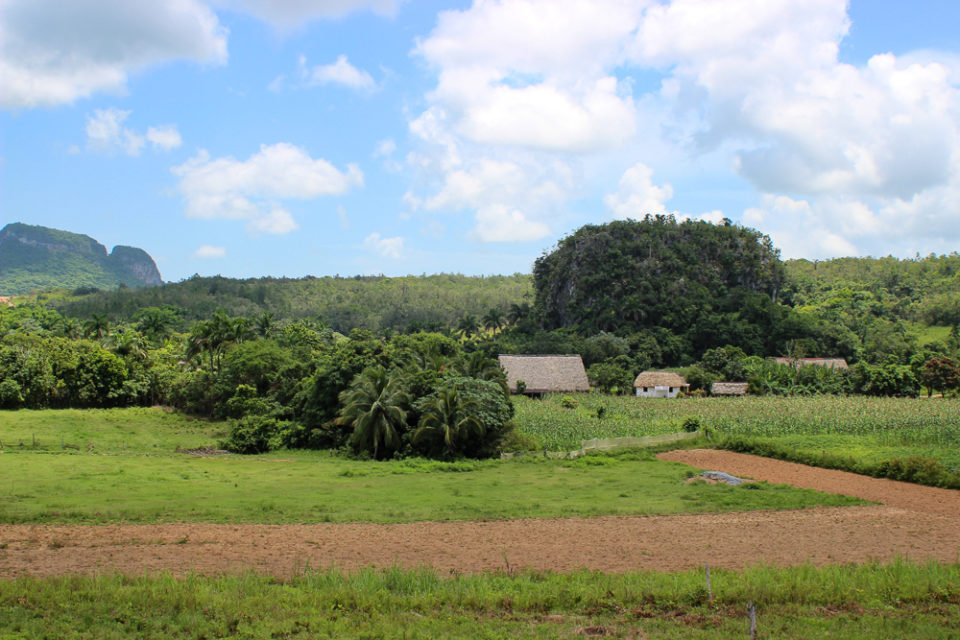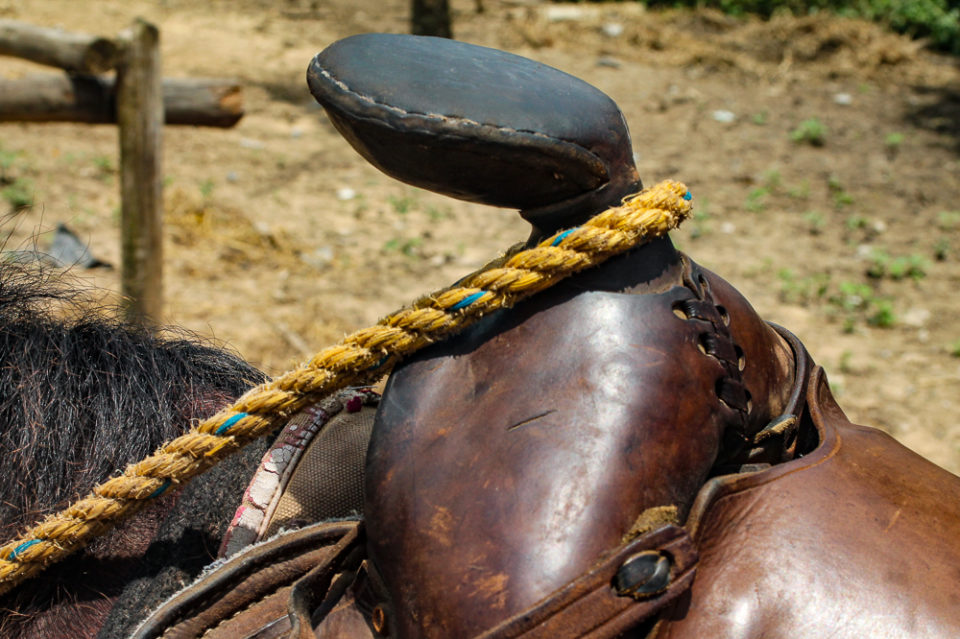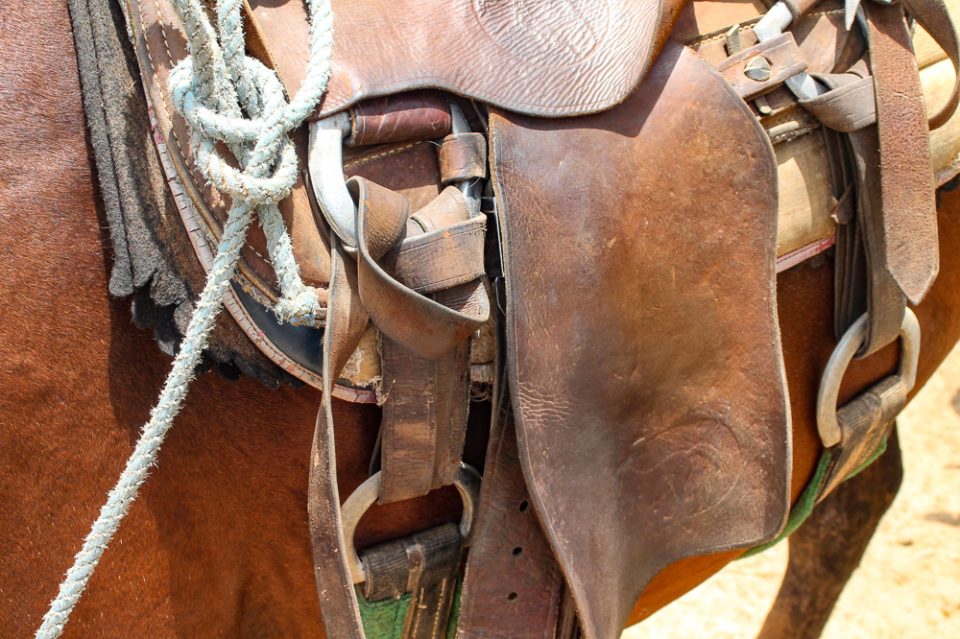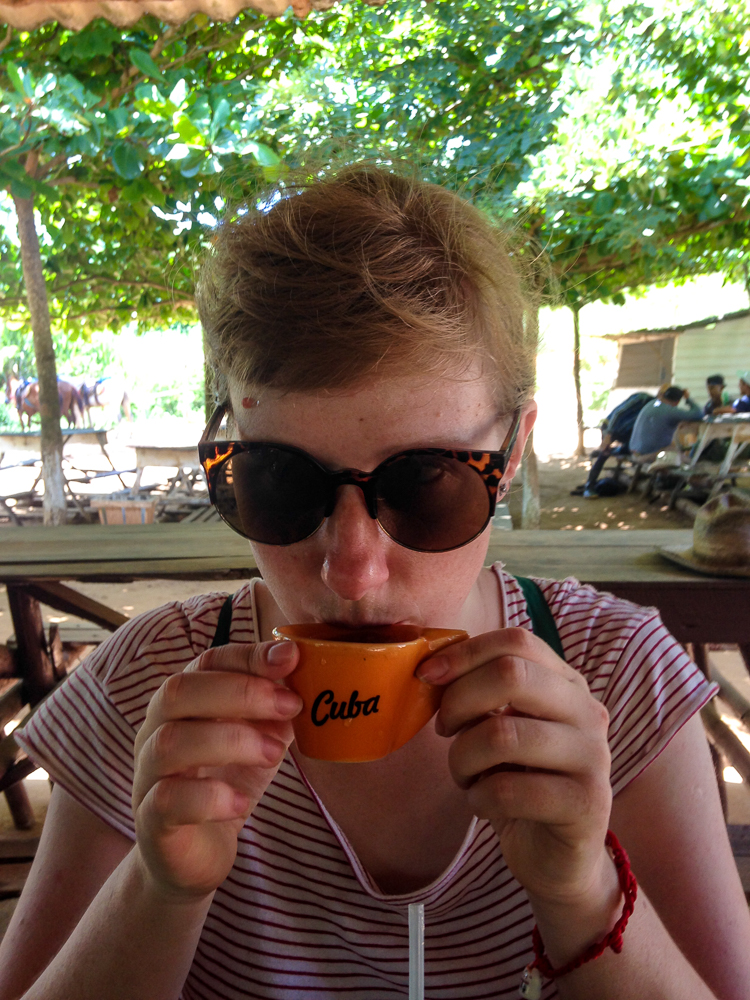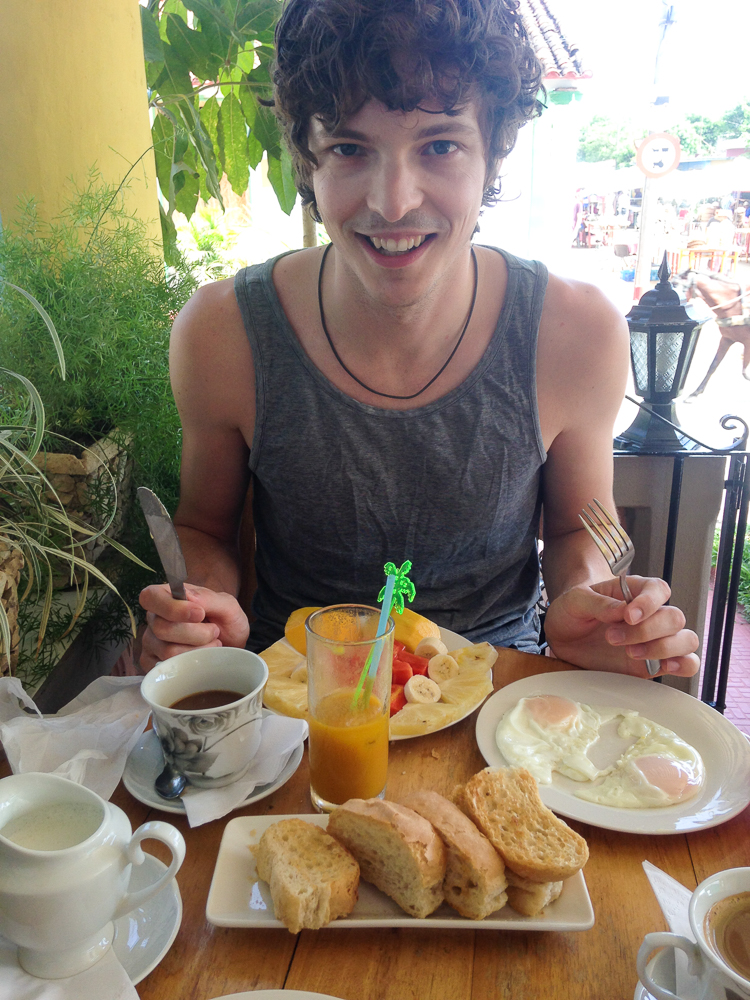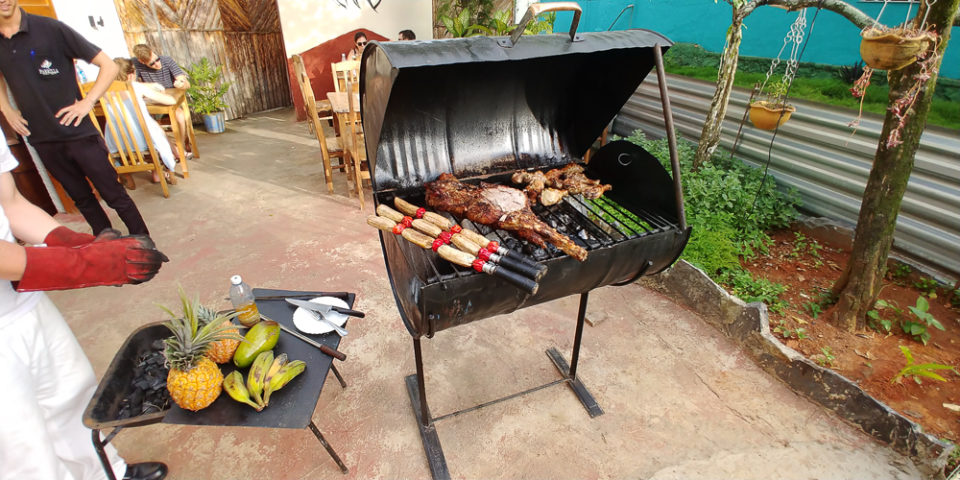Vinales Tobacco Farms, Cigars, Coffee & Rum
Published by CamDarling on
Vinales, Cuba was a real contender for our favorite destination on the island. We had a wonderful experience, were welcomed by friendly faces and I got to ride a horse (not just in the wagon) for the first time in my life. Alisa overcame her fear of horses, finally got to taste the famous cigars and every meal was accompanied by generous amounts of mojitos and cuba libres with local rum. Where Trinidad gave us a wonderful local experience thanks to our new familia Lionel and Maria, our stay in Vinales was a bit more main stream-tourism. Vinales is such a popular tourist destination, I’d say it’s the third most popular location in Cuba after Havana and Varadero Beach as tourist are bused in for day trips from Havana’s bigger hotels. Obviously this means inflated prices for tours and more tourist traps to take advantage of those with less travel experience. Beware of that.
Alisa and I stayed in a local Casa through Airbnb, our host Yosbiel helped us book a Tobacco Farm tour directly from the farm down the street, no agency required. We simply walked over began our half day horseback riding tour through the beautiful Vinales Valley countryside, a UNESCO heritage site and protected park surrounded by steep “mogote” mountains. I LOVED it, the feel of riding, the wind on my face and smell of the dirt roads, surrounded by small farms, palm trees and quiet scenic life in Cuba. It was perfect. But before covering the best parts, check A Few Words on Tours in Cuba, which are my words of wisdom on booking tours in Cuba.

Welcome to Vinales
Vinales is a small town roughly 1.5 hours outside of Havana in the western end of Cuba in the province of Pinar del Rio. The town of 20,000 is the center of farm country, with large tobacco farms, ranches and coffee plantations extending into the distance. The scenery of country dirt roads, rolling hills and great karst mountains that form the Vinales Valley are stunning to behold.
“Karst” is a common term in geology describing sharply ascending limestone mountains that rise like flat topped islands or peaked triangles out of the valley floor. In Vinales, you may also hear the term “mogotes” to describe the almost vertical walled mountains. It makes for beautiful scenery, and amazing rock-climbing. Hence the main rock climbing scene in Cuba is near the Vinales Valley.
The town is very small and quaint, perfect for a quiet retreat but also great for bar hoping as all the restaurants and nightclubs are on the same street, often side by side. While not as happening for wild parties as Varadero Beach, the scene is friendly and comfortable. It’s easy to meet other travelers and get together in town for food and drinks.

At the center of Vinales is a small park with a chapel and a statue of Jose Marti, the legendary revolutionary who died just months into the campaign to overthrow the Spanish in the early 20th century. Check out out article on the Jose Marti Memorial for his life story.
This park has Wi-Fi available, and it’s quite reliable (for Cuba). You can purchase a Wi-Fi access card at the Hotel Central Vinales on the corner. Across the street is a small bar that sells Mojitos for just 1 CUC ($1 USD). Tourist and locals alike can be found sitting on the benches of the park, getting internet access, face-timing friends or sending emails for business. Some locals also sell the Wi-Fi cards at a marked-up price of 3 CUC ($3 USD), so getting your hands on one shouldn’t be too difficult.
From the park, the main street “Salvador Cisneros” stretches out to the left and right. Or for those more geographically minded, it runs SW to NE. This is the main street for nightlife and food in Vinales, there are also some great Cafes on Camillo Cienfuegos just two blocks east.
Alisa and I arrived without having made any arrangements for a Casa or Hotel. While there are a few 3 star hotels outside of the town, most tourists choose to stay at a local Casa through Airbnb. There must be hundreds to choose from, so just walk around and ask for any vacancies. Alisa and I found a cute, modern looking room at Casa Yosbiel.

A Few words on Tours in Cuba
Tours is Cuba are still fairly unrefined. It’s important to manage your expectations and understand how things work in Cuba.
- Your guide may not speak English if you go with the cheapest tour. Ask around for an English guide, but expect to pay a premium for one.
- You get what you pay for and are often expected to pay extra for services, or expected to buy something along the tour, don’t expect “all included tours”.
- Everything can be negotiated, but don’t expect great service if you negotiate too hard. They can easily fuck you over if they feel you are being “too cheap”. From giving you lame horses to swapping good quality coffee or cigars for bad ones. You are at their mercy.
- Prices are higher for Americans (and Canadians). Tourists from Latin America, Europe and Asia will be quoted a lower price for most tours. Embrace it and move on.
- Most tourists are not “seasoned travelers”, they are often bused in on group tours from big hotels in Havana. They have no real gauge for what things actually cost in Cuba. Prices reflect this reality.
- Money talks in Cuba, but don’t use it arrogantly. Cuban people are very proud. The “I paid, so I expect this and that” attitude in Cuba won’t get you anywhere.
Vinales Tobacco Farms
A tour of a tobacco plantation had been on our “Must Do List” for Cuba since before we even booked our flights. The most iconic posters of Cuba always include their famous Cigars, the Best in the World. We were told Vinales was the best place in Cuba for exploring the tobacco farms. This is because the Vinales Valley is a protected region in Cuba and UNESCO World Heritage Site since 1999. Only locals are allowed to farm inside the government owned park, so production is very limited.
Alisa and I didn’t book a tour in advance, that’s hard to do in Cuba. We simply set out down the main street with a tip from our host Yosbiel to head out of town to the North East, past where the main road bends North (Left). We just continued straight until asphalt gave-way to dirt, the farmstead is down a small dirt road on the left about 500 meters from the bend. If you get lost, just ask a local “Cavayo” or “Granja de Tobaco” meaning horse or Tobacco Farm.
There are dozens of small local farmsteads surrounding the small town, they all offer fairly similar experiences so don’t worry if you end up at a different one. During July, the Tobacco had already been harvested and most of it was already shipped out for rolling into Cigars. The drying huts only had a few remaining dried tobacco leaves to show tourist, I presume. The leaves are dried, then partially re-hydrated for rolling. This supposedly reduces the nicotine level.
From Seed to Sale: A Cigar
We were told the government collects roughly 90% of all the tobacco harvested in Vinales. The distribution and sale of Cigars is done exclusively by the government of Cuba. The remaining 10% can only be sold directly from the farm in Vinales. This 10% of the harvest and the tourism they’ve created is what supports the thriving community of Vinales.
Juan, our guide and salesman spoke perfect English. He sat us down under a thatch roofed hut, surrounded by the nearby crops.
Making a Cigar is an art in Cuba, they’ve been growing and processing tobacco since at least 1676 under the rule of the Spanish Empire. Different strains of plants have come and gone, new technology has been introduced and then scrapped. Bad weather like hurricanes, droughts and flooding have devastated crops, making cigars from certain years collectors items and highly valued.
Today, the highest quality cigars are produced using traditional techniques by master “Torcedores” who roll the cigars. These master craftsmen are said to be able to distinguish the different leaves, from different strains just by feel and smell. Rather than explain, here is a quick video on processing tobacco leaves into Cigars.
The average cigar costs around $16 USD, but can climb as high as $50 or as low as just $2 for a single brandless cigar. This short farm tour doesn’t cost anything as it’s part of the buying process, but you are expected to buy. We each purchased just 5 cigars for $4 each, since none of us are smokers. I have to admit, the smell of a fresh cigar is amazing. We dipped one end in honey and rum, together it created this delicious fusion of flavors. For Cubans, Cigars add more than $500 million USD to the Cuban economy each year, making it one of the largest industries on the island.

Horseback Riding Tour
At the local farms, horseback riding tours are usually available for $30 to $40 per person. But you’ll need to add 10 to 20 CUC for your lunch, drinks and buying cigars, rum or coffee to take home. So assume the total tour runs between $60 to $75 CUC per person ($60 to 75 USD). It’s expensive for Cuba, yes, but equivalent to just one night out on the town in Canada or the US… It was our one splurge for this trip.
The tours are 3 to 4 hours long through the local countryside with stops at the Coffee and Rum Tasting (below) with a brief lunch break (food not included) at a small cafe hut in the middle of the Vinales Valley.
In our last Cuba article on Trinidad, many horseback riding tours take tourists through the countryside to the nearby waterfalls. Alisa and I ended up taking a horse pulled wagon, a fun and wild ride. So Vinales was our last chance to truly experience a countryside horseback ride, in the saddle, in Cuba. I was really excited, I was looking forward my first ever horseback ride and the stunning Vinales Valley was the perfect setting for a a half day ride. I’m glad to say the horses were very healthy, well groomed and well equipped.
Our guide Pedro didn’t speak any English, but he knew horses. English guides may be available for a higher rate, so that you can ask questions about the local town and listen to amazing folk tales.
Conquering Your Fear of Horses
Our horseback ride started at the farm, we took the time to explain in Spanish to Pedro that Alisa has a strong fear of horses. She needed to sit on the horse for a few minutes and be led around the farm until she felt comfortable and confident. Pedro was happy to help out… and he also found it mildly amusing that Alisa was so unfamiliar with horses. I guess everyone in Vinales learns to ride from a young age. But for us, it was a new and awkward experience.
For myself, I’m not that scared of horses but it took me quite a while to get my rhythm right in the saddle even at a canter (slow speed). When I tried to gallop (faster speed), I was bounced all over and scrambling to hold my position. When I see videos like this little girl, i’m amazed. After a good 10 minutes we set out into the rolling hills and fields. The horses know the way as they’ve done this tour hundreds of time, so there isn’t a need to steer but you’ll want to practice steering early on for when the horse starts to take the wrong way at a fork in the road, or should you need to navigate mud puddle or rocky slopes.
In the high season, you find dozens of other tourists riding through the scenic countryside. In July, we were only a handful of riders. Some of the stables were empty while others were filled with horses. Parents and children usually rode double on the horses. After a good hour of riding, we pulled into the rum and coffee tasting facility – a wood and thatch hut in the middle of the Vinales Valley, really simple but busy with tourists. On our route there were no cars, only tractors and horses which was perfect!
Rum & Coffee Tasting
The rum and coffee tasting was a nice refreshing break from the heavy sun and saddle. We found ourselves a spot at the picnic tables and ordered a few drinks to cool off. Mojitos and mixed cocktails were on the menu, see photo below. We got a brief tour and explanation of how coffee is grown and processed in Cuba from our salesman who is also a blackbelt in jiujitsu on top of being an expert on local Cuban coffee and rum.
To be clear, the tasting of coffee and rum is part of the sales-pitch, and you are strongly encouraged to buy a bottle. The coffee comes pre-ground in a plastic bottle, some tourists have complained of it tasting like dirt, suggesting it may have been cut with poor quality beans or recycled grinds. I assume these reviews are real. If that worries you, slide your salesman 5 CUC, he’ll make sure you are taken care of.
Coffee in Cuba
Cuba was introduced to Cuba in 1748 but it didn’t reach full scale production until the 18th century thanks to the help of refugee French Colonials who fled from Haiti during their revolution. The french overhauled Cuba’s coffee cultivation and production methods, creating a coffee culture and drink similar to France but distinctly Cuban. I’m talking about the Cafecito (Video).
They primarily grow Arabic coffee like you’d find in Ethiopia or Yemen. Roughly 60% of coffee grown globally is arabic and Islamic scholars were the first to formally record it’s effects as a stimulant. But production of coffee in Cuba has been difficult, not through a lack of suitable land but from a lack of proper equipment and access to markets to export it. Production in Cuba fell from an all time high in 1989-1990 to just 1.5% of that level in 2008 (7,000 60 lbs bags). Since then, the industry has recovered to around 30% of the 1989 level. For many years Cuba had a shortage of coffee, so the locals cut the ground coffee with other ingredients like chick peas.
Rum in Cuba & The "Cuba Libre"
The other key industry in Cuba is rum production, the key ingredient in my Rum & Coke, or “Cuba Libre” (Recipe Video) as the locals call it. Cuba was essentially founded as a sugarcane colony, with the sugar trade being among the first and most important industries for Imperial Spain. Slaves were brought in to work the plantations from Africa but even as far as China.You may have heard of Havana Club, one of the most popular and widely available rums from Cuba has a small museum in Havana open for tours.
Rum that came out of Spanish Colonies is called “Anejo Rum” with a smoother taste and lighter color, it’s made from fermented and distilled the sugarcane extract, molasses. Rum is Cuba, including Havana Club is usually 30% to 40% alcohol. Former British Colonies in the Caribbean typically made darker, stronger rums up to 65% alcohol, my favorite being Woods Navy Rum.
The color of the rum comes from the aging process, oak barrels produce a darker color while rum aged in a stainless steel tank will remain colorless, flavoring and spices are added in the final blending process.
In Vinales, one of the local rum produced is <La Occidental which isn’t actually classified as a rum, but rather a flavored spirit. That’s because this local drink is made with both distilled guava and sugarcane extract. The majority of rum in the world is made in the Caribbean islands and Latin america, few countries have such a rich history of rum production as Cuba.
In 1898, Teddy Roosevelt and his troops landed on the shores of Havana during the US occupation of Cuba during the war in independence from Spain. The US soldiers brought over Coca-Cola soda, as it was a great stimulant and a very concentrated beverage for energy (because it’s just liquid sugar). At the time, Havana was drowning in excess rum they couldn’t export to Spain, it didn’t take long before the two ingredients were combined, together with lime. Then, a Captain in the US Corps while making a toast held up a Bacardi Rum & Coke and declared “Por Cuba Libre” meaning For Cuba’s Freedom or “Free Cuba” (from Spain). This is simply a folk tale, one I wish to believe is true.
Vinales Airbnbs - Yosbiel Casa
Alisa and I didn’t book an Airbnb in advance, as we were set to arrive in the mid afternoon there was lots of time to shop around for a place upon arrival. It was the low season afterall. We found a place on Airbnb called “Yosbiel Casa” for $17 per night, we didn’t book it but simply walked down the street to look for it. Vinales isn’t very big, just asking around is enough to find anything you need. When we arrived they wanted $25 per night…
You see, the Casa owners in Cuba almost exclusively rely on Airbnb for their bookings. So they are willing to discount the price for a great review. Easy, we agreed to book it on Airbnb for the cheaper price so they could get our review. We walked to the park, got online and booked our room. The rooms were beautiful and clean. The bed were soft and most importantly there was aircon! We did have a private bathroom as well although the main living area is shared (no one else was there during our stay).
Yosbiel and her husband live in one of the other rooms in the apartment. It’s a small space for a family with two young kids, but really shows just how much they rely on renting out these rooms. The kitchen is an outdoor space in the back, Yosbiel will prepare an amazing local dinner should you opt for that extra option. We didn’t, as we preferred to find a nice patio near the center of town to soak in the nightlife atmosphere.
We couldn’t have been happier with our stay. Yosbiel gave us great advice for the local tours available and what dishes to look for and where to find them if we were to eat in town. They really listened to us, giving suggestions that match our taste and tours for our budget, unlike the tour operators, the Casa owners have an incentive to only recommend good and credible tours since they need 5 star reviews.
She said to mention “Yosbiel sent us” when we found our Tobacco Farm Tour. Perhaps she gets a commission from our tour, so we mentioned her when we arrived.
Tip: IF you have some spare kids books in English lying around, consider bringing them to Cuba to give to the Casa owners. Yosbiel and others who run a Casa are young families with kids, who’d love toys and books from English countries. These kinds of goods are hard to get in Cuba.
Breakfast in Vinales
Breakfast in Cuba is delicious and light. I usually only eat something small for breakfast in the early morning, but Cuba made me gorge myself as early as 7 am each day.
A typical breakfast consists of fresh fruit: Bananas, Papaya, Mango and Pineapple, then some eggs, bread with nice and thick Cuba butter. Cuba’s butter and milk is really good, a much higher quality than even the organic products in the US.
Most importantly, we had fresh mango juice and Cuban Coffee! The coffee is prepared in a small cup, just a little larger than an espresso. Starting my day with a rich cup of Cuban Coffee was blissful perfection! We ate at 100% Cuba, which is a few blocks away from the main street about midway through the town.
Local Dishes - Ropa Vieja
One of the biggest complaints from travellers about Cuba is the food. Since Cuba is cut off from trading with most countries due to the US embargo, food is sourced locally. Most dishes include beans, lettuce, corn, and grass fed meats like pork or beef.
Tip: Stick to Local Cuban Recipes. Don’t order Americanized food, you’ll be disappointed. Hotels and restaurants trying to recreate American, or even Chinese food simply don’t have the ingredients and chefs to pull it off. For example, don’t order steak, pizza or hamburgers.
Since I don’t write about food, it’s not my thing, I recommend checking out 16 Traditional Cuban Foods from Spoon University. Save it for offline viewing or write them down in your journal.
Alisa and I tried Ropa Vieja at the local BBQ Restuarant “Cerdo Pollo”. Yosbiel recommend we try it…probably the best dish we had in Cuba. It’s essentially Cuba’s version of pulled pork, with bell peppers. The side dishes included rice (from Vietnam), pumpkin, spicy beans and avocado.
More Info for Cuba
If you are still planning your trip to Cuba, check out our List of Articles for Cuba. We started off with a guide: Arriving in Havana & How to Prepare, including tips on Cuban currency and dealing with No Internet Access for bookings and staying in touch.
For your pre-trip downtime, check out our List of Recommended Books, Movies and Podcasts! We are always adding more good stuff you might like.
If you find this useful, follow us on Twitter and Instagram!


